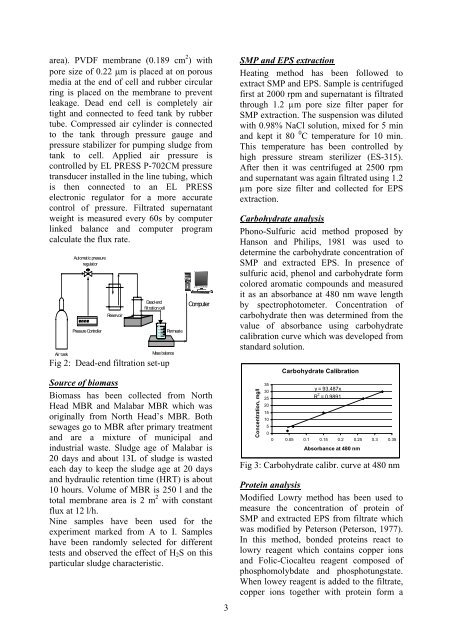Control of membrane fouling by Hydrogen Sulfide (H2S) diffusion ...
Control of membrane fouling by Hydrogen Sulfide (H2S) diffusion ...
Control of membrane fouling by Hydrogen Sulfide (H2S) diffusion ...
You also want an ePaper? Increase the reach of your titles
YUMPU automatically turns print PDFs into web optimized ePapers that Google loves.
area). PVDF <strong>membrane</strong> (0.189 cm 2 ) withpore size <strong>of</strong> 0.22 µm is placed at on porousmedia at the end <strong>of</strong> cell and rubber circularring is placed on the <strong>membrane</strong> to preventleakage. Dead end cell is completely airtight and connected to feed tank <strong>by</strong> rubbertube. Compressed air cylinder is connectedto the tank through pressure gauge andpressure stabilizer for pumping sludge fromtank to cell. Applied air pressure iscontrolled <strong>by</strong> EL PRESS P-702CM pressuretransducer installed in the line tubing, whichis then connected to an EL PRESSelectronic regulator for a more accuratecontrol <strong>of</strong> pressure. Filtrated supernatantweight is measured every 60s <strong>by</strong> computerlinked balance and computer programcalculate the flux rate.Air tankAutomatic pressureregulatorPressure <strong>Control</strong>lerReservoirDead-endfiltration cellMass balanceFig 2: Dead-end filtration set-upPermeat eComputerSource <strong>of</strong> biomassBiomass has been collected from NorthHead MBR and Malabar MBR which wasoriginally from North Head’s MBR. Bothsewages go to MBR after primary treatmentand are a mixture <strong>of</strong> municipal andindustrial waste. Sludge age <strong>of</strong> Malabar is20 days and about 13L <strong>of</strong> sludge is wastedeach day to keep the sludge age at 20 daysand hydraulic retention time (HRT) is about10 hours. Volume <strong>of</strong> MBR is 250 l and thetotal <strong>membrane</strong> area is 2 m 2 with constantflux at 12 l/h.Nine samples have been used for theexperiment marked from A to I. Sampleshave been randomly selected for differenttests and observed the effect <strong>of</strong> H 2 S on thisparticular sludge characteristic.3SMP and EPS extractionHeating method has been followed toextract SMP and EPS. Sample is centrifugedfirst at 2000 rpm and supernatant is filtratedthrough 1.2 µm pore size filter paper forSMP extraction. The suspension was dilutedwith 0.98% NaCl solution, mixed for 5 minand kept it 80 0 C temperature for 10 min.This temperature has been controlled <strong>by</strong>high pressure stream sterilizer (ES-315).After then it was centrifuged at 2500 rpmand supernatant was again filtrated using 1.2µm pore size filter and collected for EPSextraction.Carbohydrate analysisPhono-Sulfuric acid method proposed <strong>by</strong>Hanson and Philips, 1981 was used todetermine the carbohydrate concentration <strong>of</strong>SMP and extracted EPS. In presence <strong>of</strong>sulfuric acid, phenol and carbohydrate formcolored aromatic compounds and measuredit as an absorbance at 480 nm wave length<strong>by</strong> spectrophotometer. Concentration <strong>of</strong>carbohydrate then was determined from thevalue <strong>of</strong> absorbance using carbohydratecalibration curve which was developed fromstandard solution.Concentration, mg/lCarbohydrate Calibration353025y = 93.487xR 2 = 0.9891201510500 0.05 0.1 0.15 0.2 0.25 0.3 0.35Absorbance at 480 nmFig 3: Carbohydrate calibr. curve at 480 nmProtein analysisModified Lowry method has been used tomeasure the concentration <strong>of</strong> protein <strong>of</strong>SMP and extracted EPS from filtrate whichwas modified <strong>by</strong> Peterson (Peterson, 1977).In this method, bonded proteins react tolowry reagent which contains copper ionsand Folic-Ciocalteu reagent composed <strong>of</strong>phosphomolybdate and phosphotungstate.When lowey reagent is added to the filtrate,copper ions together with protein form a
















